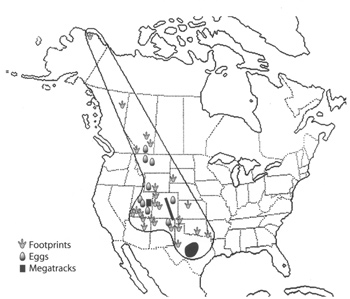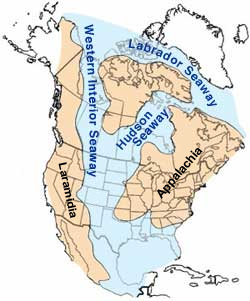At https://phys.org/print439043531.html … one mystery of fossilised dinosaurs concerns the armour plated ankylosaurs. They are often discovered belly up. How does this happen? Out of 32 two fossil specimens from Alberta 26 were belly up. A recent study has worked out it was a case of bloat and float. They are usually found in river or water channel deposits and would have flopped over as a result of turbulent water flow. They are thought to have lived along the banks of the Western Interior Seaway but we might ask – was it really a seaway or the remains of a gigantic tidal wave of water that swept across North America.
At https://creation.com/watery-catastrophe-deduced-from-huge-ceratopsian-di… … which concerns horned bird hipped dinosaurs of which the Triceratops is the largest and most common example. Their remains also turn up in Alberta – found in what are described as bone beds. Such deposits can contain hundreds of dinosaurs – dumped in a single location. Tricerotops and its close relatives, the Ceratopsia, are found in a couple of dozen bone beds in southern Alberta. Most appear to have been caught up in a flood of water and naturally this link points a finger at Noah's Flood. All we need to take onboard is that a lot of dinosaurs in Canada died from drowning and being washed away in a massive torrent of water …
 … this is a map they produce of flood deposits in western North America, based on the discovery of dinosaur eggs, tracks and bone beds. Dinosaur graveyards also occur in Montana and Wyoming, and various localities around the world.
… this is a map they produce of flood deposits in western North America, based on the discovery of dinosaur eggs, tracks and bone beds. Dinosaur graveyards also occur in Montana and Wyoming, and various localities around the world.
At https://en.wikipedia.org/wiki/Western_Interior_Seaway … we have a discussion of the mainstream theory of a large inland sea that existed in the Cretaceous period, dividing North America into two parts ….

… there is no reason why a seaway could not have existed if the geoid of the Earth differed, displacing the oceans and sea beds. However, the Cretaceous came to an end rather abruptly, generally accepted to be the result of an asteroid strike. That may have caused a giant tidal wave and these bone beds could theoretically have been created by the displacement of water from the Gulf. I am not saying that is what happened but we learn from the Wiki that chalk was also laid down in some places – composed of the shells of algae living in the open ocean. Did these creatures live at the bottom of the Seaway – or were they thrown up in a tidal wave.
The Seaway appeared first in mid Cretaceous geology, and stretched 1000km. Little sedimentation occurs along the eastern side but the western boundary is a thick clastic wedge eroded from the Savier orogenic belt. Chalk formations also occur – up to 70 feet deep in places. In western Europe the chalk formations were laid down in three stages – divided by hard chalk bands. These are thought to be former sea floors as worm holes and burrows can be seen in some of them. Even if a Seaway existed in the Cretaceous its point of arrival may have been swift. The Creationist view is that it was short lived (40 days and 40 nights) but the geological view is that it was a lot longer by far. Various marine creatures also occur along the Seaway – such as bivalves.
